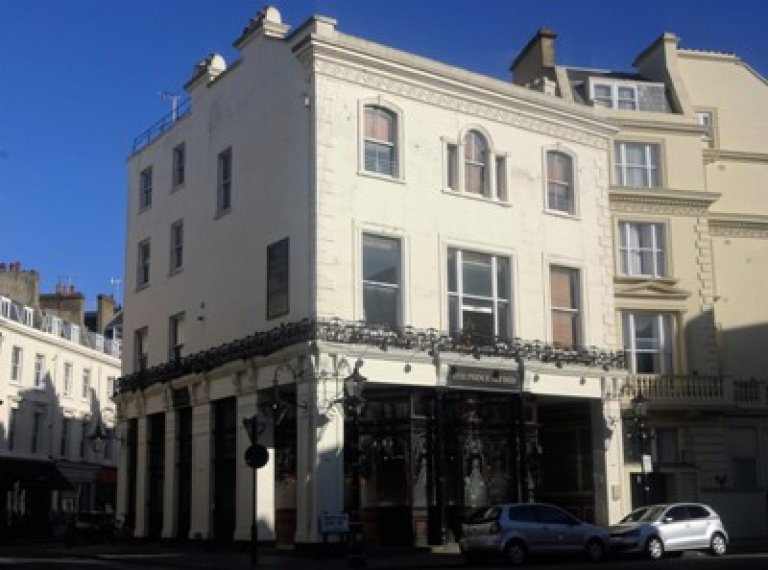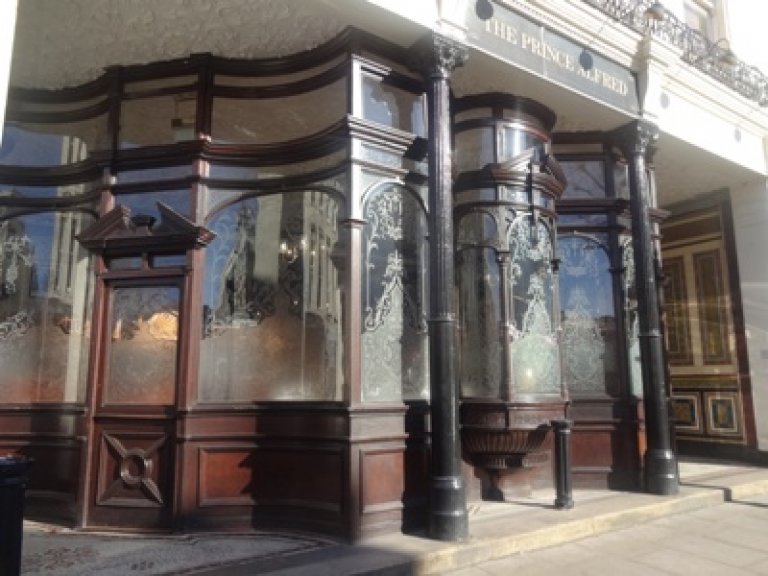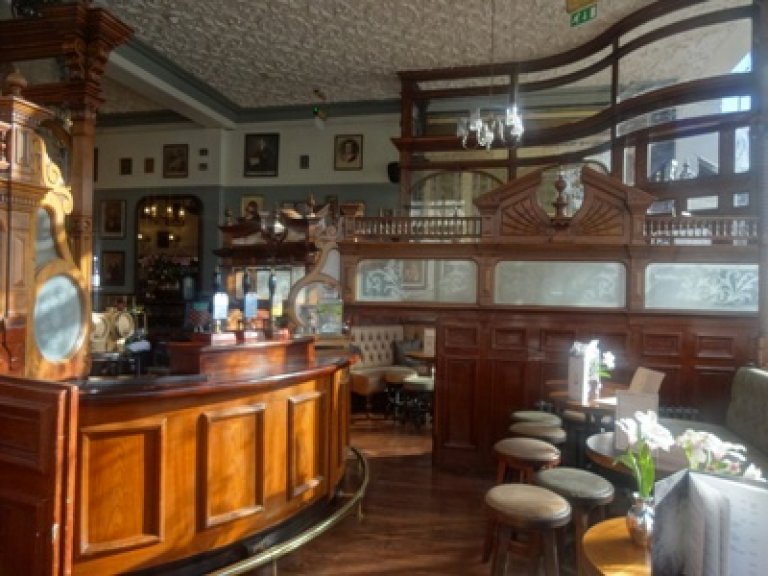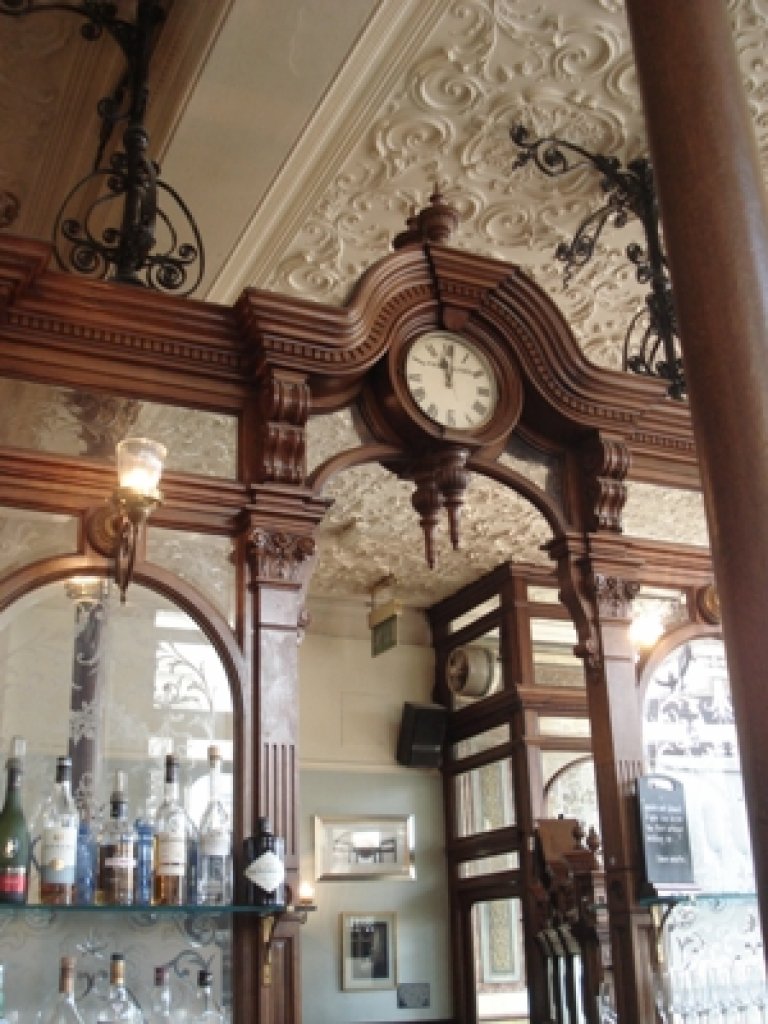Prince Alfred
5A Formosa StreetMaida Vale
W9 1EE
This pub is not only a grade II* listed building, it is also a Three Star pub on CAMRA’s Inventory as a pub of Exceptional National Historic Importance, and the description is as follows: “The Prince Alfred is the best example now existing of how London pubs about 1900 were divided up into numerous separate spaces, each occupied by a particular group of individuals and social groups. The layout of many small drinking compartments is a style also seen at the Argyll Arms, Soho, London W1, Princess Louise, Holborn, London WC1 and Salisbury, Covent Garden, London WC1. Outside, the Prince is nothing terribly exciting – a three-storey Italianate building in keeping with its surroundings – but inside shows to perfection how late Victorian drinkers liked their pubs. The building went up in about 1865 but was given a complete refit around 1898. From outside look carefully at the exposed ceiling on the ground floor and you can see how timber and glass screen-work has been inserted, cutting across the patterned decoration. Also note the tiles and mosaic in the entrance. The interior has the only peninsula-style servery to retain all of its original surrounding drinking areas – no fewer than five of them, each with its own external entrance. They are separated by timber and glass screens, all of them with a low service door for the use of, say, pot boys and cleaners. The smallest compartment has a set of snob screens – swivelling glazed panels, which gave posh patrons a sense of separation from the serving staff. Other Heritage Pubs with snob screens are Bartons Arms, Aston, Birmingham; Lamb, London WC1; Posada, Wolverhampton , West Midlands; Starting Gate, London N22; Bunch of Grapes, London SW3; Crown, London N1; and Crown & Greyhound, London SE21 but these have been moved. In the middle of the servery is a wonderfully tall, carved fitment, which is secured to the ceiling by ironwork. All this late Victorian work gives the pub a delicate Rococo feel. A refit in 2001 transformed the character into a café-restaurant establishment with over-prominent kitchen and dining room, and totally inappropriate furnishings in the historic part: counter re-fronted at this time.”
Quotation from The Local: “Like everything else in the pubs, the Saloon Bar varies from house to house. You may have enormous Saloons as in the Windsor Castle at Victoria, small crowded Saloons as at the Warwick Castle, bright, snug Saloons as at the Canterbury Arms in Lambeth Marsh, architectural Saloons as at the Prince Alfred, which Ardizzone was irresistibly tempted to draw.” The book has a coloured illustration of the Prince Alfred’s saloon bar opposite this description. It also has a black-and-white illustration of men playing darts at the Prince Alfred in Malcolm Yorke’s introductory chapter in the facsimile version of the book. This illustration is also found in the Games chapter in Back to the Local. The listing description is as follows: “Public house, built 1863 and remodelled in around 1898. REASONS FOR DESIGNATION The Prince Alfred, Formosa Street, London, built 1863 and remodelled in around 1898, is listed at Grade II* for the following principal reasons: Architectural interest: * as a remarkably well-preserved 1890s pub interior, combining a range of fixtures of distinction with a complete compartmentalised bar plan; * for the intricacy and flamboyance of the sinuous bowed-glass pub frontage, with its corresponding wall tiling, mosaic flooring and hanging lamps, all carefully integrated in the 1890s with the refined stuccoed elevations of 1863; Historic interest: * as the best example nationally of the type of highly compartmentalised pub arrangements found in urban pubs at the end of the C19, giving a tangible and sense of how such pubs would have functioned; * as a high-status pub remodelling scheme undertaken at the height of the Victorian 'pub boom', retaining an eclectic and rare range of fittings from the late 1890s; Group value: * with the pair of cast-iron lamp standards to Castellain Road, installed as part of the remodelling of the pub in around 1898 and listed separately at Grade II, along with the Grade II-listed 2-18 Formosa Street, 1-5 Formosa Street, and, to the south on Warrington Crescent, Colonnade Hotel Warrington Lodge. HISTORY: The streets around Warrington Crescent and Warwick Avenue were set out from the 1850s on land that formed part of the Bishop of London’s estate. Development of the area was characterised by substantial stuccoed houses, with those built along the northern part of Warwick Avenue (originally named Warwick Road West and later Warrington Terrace) completed by 1863. Formosa Street was laid out at the same time to function as a connecting service road lined with shops, following the pattern of development established by the 1824 masterplan by Samuel Pepys Cockerell for the Tyburn Estate or ‘Tyburnia’, to the south of Paddington. The Prince Alfred was built at the junction of Formosa Street and Castellain Road (known as Warwick Road North prior to renaming in 1869) as part of this early development of the area; recorded under its present name in trade records from 1869. Originally serving as a public house and hotel, with rooms to the upper floors, the Prince Alfred’s upper rooms were converted to private residential accommodation later in the C20. The present form, arrangement and fit-out of the Prince Alfred is principally a result of a complete remodelling undertaken in around 1898, at the height of the London ‘pub boom’. The last years of the 1890s saw extravagant spending on new pubs and remodelling of existing buildings as breweries and publicans jostled for market control within the context of strict control of license distribution, and this heightened expenditure is much in evidence at the Prince Alfred. The highly compartmentalised bar arrangement of the remodelled pub was a characteristic feature of London pubs of the late C19, though multiple, smaller drinking spaces began to give way to larger saloon bars, which became fashionable in the 1890s, as exemplified at the nearby Warrington Hotel (Grade II; List entry 1066160) and Crocker’s Folly (Grade II*; List entry 1357150). The work of around 1898 at the Prince Alfred introduced a peninsula bar servery, projecting out from the back wall with five distinct compartments radiating out from it, all divided by ornate carved timber screens. The smallest of the bar compartments was the ‘ladies’ bar’, as identified by etched glazing to the door from Castellain Road shown in archive photographs, a feature that survived until at least the 1980s, as noted by Mark Girouard, (‘Victorian Pubs’, 1984, p73). The room is also distinguished by its rotating glazed screens (‘snob screens’) to the bar counter, which afforded greater privacy to customers here. To the rear of the pub a billiards hall was built as part of the late C19 remodelling; this being another common feature of London pubs of the 1890s and is readily identifiable by the large haystack rooflight above the centre of the single-storey extension to Formosa Street. The Prince Alfred appears to have seen relatively little alteration over the course of the C20. The pub was first listed in January 1970 and the retention of its 1890s compartments was cited as a notable London survival by Girouard (‘Victorian Pubs’, p69), at a time when the opening-out of sub-divided pub interiors had become commonplace. The former billiard room was converted to an additional rear bar room, with a section of counter added to serve this area, part of which is visible in a scene set in a pub in David Bowie’s short film ‘Jazzin’ for Blue Jean’ (1984). A phase of remodelling principally focussed on the former billiard hall and the cellar beneath was carried out in 2000. This involved converting the former billiard room into a restaurant and relocating the toilets accessed from this part of the pub to the cellar beneath. Windows and doors to Formosa Street were replaced and the bar counter to this area (a C20 addition) was reconfigured to integrate a ground-level kitchen, with the stairs down to the cellar replacing the former kitchen area. Part of the main bar counter was refronted as part of the 2000 work. Damage to a section of the ceiling above the servery in April 2015 caused a period of closure, requiring the lincrusta ceiling to be replaced in facsimile with a lath and plaster ceiling. prior to reopening early in 2016. DETAILS: Public house, built 1863 and remodelled in around 1898, including a new ground-floor facade and complete interior refit. Minor alterations made in the early 2000s. MATERIALS: stuccoed brick with slate roof. Etched-glass windows, wall tiles and mosaic flooring to the pub frontage. PLAN: square ground-floor plan with a long, peninsula servery connected to highly compartmentalised drinking areas. Extended public area to east for dining area, formerly a billiards room. EXTERIOR: three storeys with the principal three-bay façade to Castellain Road and return elevation to Formosa Street of three bays with a single-storey portion at the north-eastern end for the former billiard hall. A pair of fluted iron composite columns support the fascia and dentilled cornice, installed as part of the late-C19 scheme to structurally support the upper floors and enable the sinuous, richly-detailed timber and etched glass recessed front to the pub to Castellain Road. This extends around the corner to Formosa Street, featuring bowed windows with etched and engraved glass with recurring motifs of birds in foliage and draped garlands. Some window panes are later replicas. A central projecting window bay is flanked by a series of canted windows which sweep back in ogee curves to the side entrances. There is a consistent fielded-panel riser at the base of the front, with arched windows and a continuous dentilled course above. Composite columns and a broken pediment feature in the central window bay and each of the bar entrances. There is mosaic flooring to the recessed corner at the junction with Formosa Street and to the southerly entrances. The wall of the right-hand entrance is tiled with plain and embossed tiles in cream, olive, blue and brown. The ceilings over the entrance areas are of elaborate scrolled plaster work, forming a continuation of that inside (replaced following damage in 2015). There are pairs of hanging lamps with tapered glazing on iron swan-neck brackets to the fascia of both the Formosa Street and Castellain Road elevations. The arrangement and fenestration of the upper floors date to the original phase of building, of 1863. The first floor has a central tripartite sash window with further sashes to outer bays, set in architraves. The second floor has a central Venetian window flanked by keyed segmental-arched sashes. There is a consistent Italianate scrollwork frieze and cornice to both elevations and a continuous ornate cast-iron balustrade runs above the fascia, partially screening the first-floor windows. The rear billiard hall is a single-storey addition of around 1898, with a shallow-pitched roof and a central haystack rooflight. To Formosa Street the elevation has a series of sash windows and a fire exit door, all replaced as part of the 2000 work. INTERIOR: the main part of the pub fronting to Castellain Road is divided into five bar compartments, separated by screens, radiating out from a long servery fitted with an island bar back gantry. The ornate timber bar screens have etched glass in their upper parts and are surmounted by carved broken pediments and flanked by delicate balustrades. Doors in the lower part of each screen allow service access, originally for ‘pot boys’ to collect glasses without needing to enter from the street. The small bar adjacent to the southern entrance (originally the ‘ladies’ bar’) has counter-top ‘snob screens’ with rotating etched glass panels to give privacy to customers here. The bar counter was refronted as part of the work of 2000, with applied moulded borders to give the appearance of fielded panels. The tall island bar back has classical motifs, a central clock bearing the pub’s name and glazed sections to the shelving of the two flanking panels (the middle section left open). The upper part of the island bar back is fixed to the ceiling by ornate iron brackets. The back wall of the servery has a further elaborate bar back fixture, terminating in decorated coving and a broken pediment. The large, southerly bar has a tiled dado with brown, light and dark blue and turquoise tiles and a brown and white marble fire surround. A high-level, curved wooden screen forms the entrance to the restaurant (formerly the billiards hall) from this bar. The bar counter and back in the restaurant area is a replacement of 2000, broadly matching the fronting of the other parts of the counter from this date. Steel trusses integrating the central haystack rooflight are visible within the restaurant area and there is a classical timber fire surround to the south wall. The cellar beneath the Formosa Street former billiard hall has flagstone floors, four brick vaults (converted to dining booths) and some original shelving of stone and slate. The WCs at this level were installed as part of the work of 2000. The staircase from the entrance in Formosa Street leading up to the residential accommodation retains its mid-C19 pierced iron balusters.”
The WhatPub link is here: WhatPub/Prince Alfred
The Pub Heritage Group link is here: PHG/Prince Alfred
The Prince Alfred featured on the Evening Crawl of Maida Vale in May 2002, the Evening Crawl of Maida Vale and Bayswater in December 2005, the Daytime Crawl of NW London and Maida Vale in October 2006, the Viva Victorian: Evening Crawl of Maida Vale and Maida Hill in December 2012, the Rural Rides: Daytime Crawl of Kensal Green, Maida Hill, Maida Vale and St John's Wood in February 2017, and the Grand Pubs Near the Grand Union Canal: Evening Pub Tour of Maida Vale, Tyburnia and Paddington in December 2023.
 [[image;id=4153]]
[[image;id=4153]]







